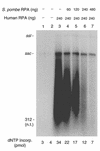Species specificity of human RPA in simian virus 40 DNA replication lies in T-antigen-dependent RNA primer synthesis
- PMID: 11095685
- PMCID: PMC115162
- DOI: 10.1093/nar/28.23.4742
Species specificity of human RPA in simian virus 40 DNA replication lies in T-antigen-dependent RNA primer synthesis
Abstract
Replication protein A (RPA) is a three-subunit protein complex with multiple functions in DNA replication. Previous study indicated that human RPA (h-RPA) could not be replaced by Schizosaccharomyces pombe RPA (sp-RPA) in simian virus 40 (SV40) replication, suggesting that h-RPA may have a specific function in SV40 DNA replication. To understand the specificity of h-RPA in replication, we prepared heterologous RPAs containing the mixture of human and S.pombe subunits and compared these preparations for various enzymatic activities. Heterologous RPAs containing two human subunits supported SV40 DNA replication, whereas those containing only one human subunit poorly supported DNA replication, suggesting that RPA complex requires at least two human subunits to support its function in SV40 DNA replication. All heterologous RPAs effectively supported single-stranded (ss)DNA binding activity and an elongation of a primed DNA template catalyzed by DNA polymerase (pol) alpha and delta. A strong correlation between SV40 DNA replication activity and large tumor antigen (T-ag)-dependent RNA primer synthesis by pol alpha-primase complex was observed among the heterologous RPAs. Furthermore, T-ag showed a strong interaction with 70- and 34-kDa subunits from human, but poorly interacted with their S.pombe counterparts, indicating that the specificity of h-RPA is due to its role in RNA primer synthesis. In the SV40 replication reaction, the addition of increasing amounts of sp-RPA in the presence of fixed amount of h-RPA significantly reduced overall DNA synthesis, but increased the size of lagging strand, supporting a specific role for h-RPA in RNA primer synthesis. Together, these results suggest that the specificity of h-RPA in SV40 replication lies in T-ag-dependent RNA primer synthesis.
Figures










Similar articles
-
The replication protein A binding site in simian virus 40 (SV40) T antigen and its role in the initial steps of SV40 DNA replication.J Virol. 1998 Dec;72(12):9771-81. doi: 10.1128/JVI.72.12.9771-9781.1998. J Virol. 1998. PMID: 9811712 Free PMC article.
-
Protein-protein interactions of the primase subunits p58 and p48 with simian virus 40 T antigen are required for efficient primer synthesis in a cell-free system.J Biol Chem. 2000 Jun 9;275(23):17328-37. doi: 10.1074/jbc.M000717200. J Biol Chem. 2000. PMID: 10747950
-
An interaction between replication protein A and SV40 T antigen appears essential for primosome assembly during SV40 DNA replication.J Biol Chem. 1993 Feb 15;268(5):3389-95. J Biol Chem. 1993. PMID: 8381428
-
SV40 large T antigen functions in DNA replication and transformation.Adv Virus Res. 2000;55:75-134. doi: 10.1016/s0065-3527(00)55002-7. Adv Virus Res. 2000. PMID: 11050941 Review. No abstract available.
-
The replication functions of SV40 T antigen are regulated by phosphorylation.Cell. 1990 Jun 1;61(5):735-8. doi: 10.1016/0092-8674(90)90179-i. Cell. 1990. PMID: 2160857 Review. No abstract available.
Cited by
-
RPA complexes in Caenorhabditis elegans meiosis; unique roles in replication, meiotic recombination and apoptosis.Nucleic Acids Res. 2021 Feb 26;49(4):2005-2026. doi: 10.1093/nar/gkaa1293. Nucleic Acids Res. 2021. PMID: 33476370 Free PMC article.
-
Solution structure of the DNA-binding domain of RPA from Saccharomyces cerevisiae and its interaction with single-stranded DNA and SV40 T antigen.Nucleic Acids Res. 2005 Jul 25;33(13):4172-81. doi: 10.1093/nar/gki736. Print 2005. Nucleic Acids Res. 2005. PMID: 16043636 Free PMC article.
-
Mutational analysis of simian virus 40 T-antigen primosome activities in viral DNA replication.J Virol. 2002 May;76(10):5121-30. doi: 10.1128/jvi.76.10.5121-5130.2002. J Virol. 2002. PMID: 11967327 Free PMC article.
-
Host-specific replication of BK virus DNA in mouse cell extracts is independently controlled by DNA polymerase alpha-primase and inhibitory activities.J Virol. 2010 Jul;84(13):6636-44. doi: 10.1128/JVI.00527-10. Epub 2010 Apr 14. J Virol. 2010. PMID: 20392840 Free PMC article.
-
RPA-coated single-stranded DNA as a platform for post-translational modifications in the DNA damage response.Cell Res. 2015 Jan;25(1):9-23. doi: 10.1038/cr.2014.147. Epub 2014 Nov 18. Cell Res. 2015. PMID: 25403473 Free PMC article. Review.
References
-
- Wobbe C.R., Weissbach,L., Borowiec,J.A., Dean,F.B., Murakami,Y., Bullock,P. and Hurwitz,J. (1987) Proc. Natl Acad. Sci. USA., 82, 5710–5714. - PubMed
-
- Brill S.J. and Stillman,B. (1991) Genes Dev., 5, 1589–1600. - PubMed
-
- Erdile L.F., Heyer,W.-D., Kolodner,R. and Kelly,T.J. (1991) J. Biol. Chem., 266, 12090–12098. - PubMed
Publication types
MeSH terms
Substances
Grants and funding
LinkOut - more resources
Full Text Sources

